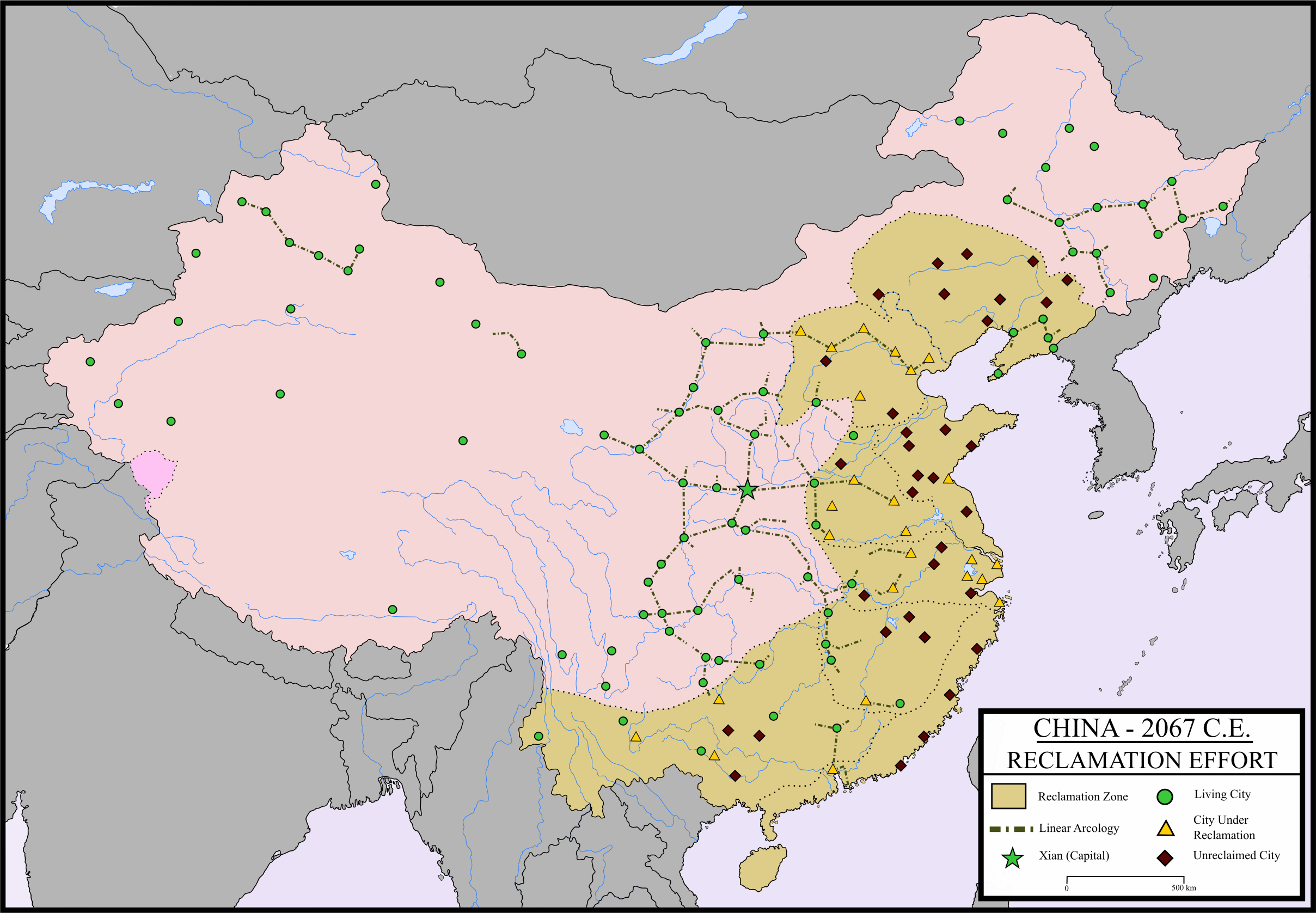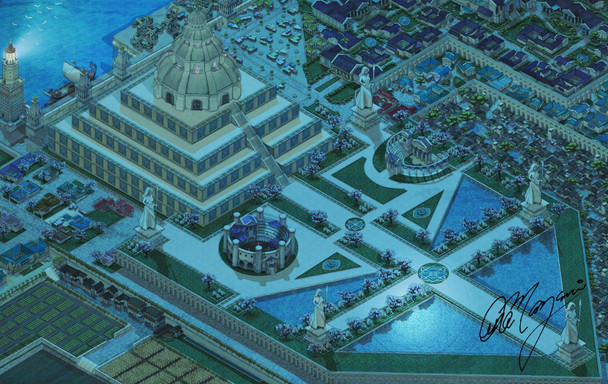HOME | DD
 machinekng — Chinese Reclamation Effort - 2068 C.E.
machinekng — Chinese Reclamation Effort - 2068 C.E.

#cyberpunk #map #2068ce #alternatehistory #china #climatechange #futurehistory
Published: 2016-07-18 04:59:22 +0000 UTC; Views: 6956; Favourites: 80; Downloads: 27
Redirect to original
Description
The precise origins of the Dactyl Rot are unknown to this day. While the leading theory is that the fungus was an isolated species, dredged up by construction on the rural Fujian coast in the early '30s, the arguments for the Northern hypothesis are still strong, and conspiracy theories abound. Regardless of how the mold was introduced to urban China, the Dactyl Rot took to the city like a duck to water. Aided by rising temperatures and sea levels, the Dactyl Rot grew rapidly on damp concrete, with finger-esque tendrils giving the mold its common name. The Chinese authorities had no idea of the threat, filing away the problem as an exaggeration. While maintenance workers complained of the mold being almost impervious to fungicide, with only the most toxic chemicals having any effect, most bureaucrats assumed that these workers were simply trying to avoid their jobs.In 2037, the public began to feel the impact of the Rot. That summer, 54,691 children across China died of fungal meningitis. 7,425 died to fungal pneumonia.
The Dactyl Rot had reached critical mass. Its spores contaminated hundreds of thousands of homes and buildings. While an infection from the Rot could be resisted by a healthy adult, children could not effectively fight off the infection, and any effective anti-fungal agent would end up being as lethal as the disease. It was also noted that miscarriage rates skyrocketed, due to fetal infection. Panic and civil unrest swept the coastal cities, demanding that something be done to halt the crisis. The government's fact finding team's report indicated that it would be impossible to reverse the Rot's spread without causing irreparable damage and dislocating tens of millions. When the report leaked, protesters began to demand the end of the Communist government. Combined with the strains of environmental degradation and the trade war with the Pan-Oceanic Trade Pact, the Chinese public was at a breaking point. Something would have to give.
In 2039, with unrest rising and the death toll climbing into the hundreds of thousands, the Chairman of the Communist Party made a public announcement.
The Party would give.
That henceforth, the Chinese Communist Party would be dissolved.
That a interim government would carry out a country-wide referendum on a new democratic constitution and a comprehensive reclamation plan for the country.
Historians and political scientists often look back to this moment, noting that the provisional government and subsequent democratic government were composed of leading members of the CCP, and that even to this day the Chinese two-party system is dominated by the same networks as it was prior to de-communization. But in the moment, it was a new era for the People's Republic.
Nearly three decades out, China's democracy is shaky, but the nation is on the road to restoration. China is still the world's second largest economy, the world's leading military power, and the Reformed Renminbi is still the world's new reserve currency. While the old cities of the coast may be consumed by the Rot, the Linear Arcology Network has become home to more than a half billion citizens. The Chinese lead Asian-Pacific Cooperation Council is the leading example of a fair and beneficial regional union, and China's Politiclubs have influence in almost every country on earth.
--------------------------------------------------------------------
From the shining mega-cities of the African coast, to the flooded streets of Old Miami. From the packed arcologies of China, to the bleak burning fields of Venezuela. From the vigorous debate of commune meeting halls in Buenos Aires, to the hushed whispers of secret party meetings in Munich. From the singing in the historicist concert halls of Montreal, to the screams over the burning slums of Moscow. From crowds of protesters in London, New Delhi, and Oran, to lonely miners on the Moon. All of it lives, all of it breathes, and all of it will one day die. All under the same twinkling light of the stars.
Our Fathers' Stars.
Related content
Comments: 10

👍: 0 ⏩: 0

👍: 0 ⏩: 0

what happened to Macau? independece? destroyed?
👍: 0 ⏩: 1

No. The referendum there returned a pro-remain majority.
👍: 0 ⏩: 0

Yikes, my first thought was that Dactyl Rot was just some kind of trench-foot-of-the-dirty-fingernails disease, but this seems much more terrifying. And thats exactly how the CCP would react to this kind of problem.
👍: 1 ⏩: 0

Was any European nation hit by the Dactyl Rot?
And I guess to reclaim these areas, the new Chinese government would need a looooot of napalm or similar to clean these areas.
And what is a Linear Arcology? I know what an arcology is, but what does that mean here? Something like a tunnel-arcology that connects the old pre-Rot-cities?
👍: 0 ⏩: 1

EDIT: Due to the trade war between the POTP and China, imports to Europe from China were rather low. Since the Dactyl Rot spread overseas through contamination in shipping containers, Europe was mostly spared. China's trade partners, on the other, hand, were hit harder. The U.S. got hit second-worst, with portions of L.A., San Diego and Seattle infected to this day.
A Linear Arcology is a type of megastructure, consisting of twenty to forty story high modules that contain a variety of commerical, residential, industrial, agricultural, and public units. Each 200m module, depending on the exact height, can support between 3,000 to 7,000 residents. The arcologies themselves only contain about half of the network's population, with the rest made up of communities along the qrcology wall that are administered by one of the arcological authorities. Various rails and hyperloops run through the arcologies, allowing for high-speed transit of people and goods throughout the network.
The Arcology network is a wonder of the modern age, and was only possible through advanced technology and massive investment by both the Chinese state and corporate partners. The arcologies were constructed using techniques that had been developed for automated construction used for exploratory mining on the moon. Automated processing units, traveling on rail and using materials from the environment, formed the structure layer by layer out of a kind of carbon nanotube reinforced concrete. Armies of workers, both organic and synthetic, followed the units, installing various piping, furnishings and wiring.
👍: 0 ⏩: 0

Wow,what happened to my country?
Why we need to do some reclamnation here?
👍: 0 ⏩: 1

One bit of terminology from the FTL, Reclamation and Reclamationism refers to restoring areas affected by climate change to their pre-crisis state. As for China in particular, the Dactyl Rot, a highly-fungicide resistant, infectious mold, made countless homes and areas uninhabitable. Either the Rot could be left unchecked, leading to the death of an entire young generation, or it would have to be reversed, which entailed essentially fumigating entire cities with a combination fire and corrosive chemicals that would linger for at least a decade. The Dactyl Rot also hit the U.S. and parts of East Africa, although these latecomers to the Rot were slightly more prepared, and were able to mitigate the damage.
👍: 0 ⏩: 0


























